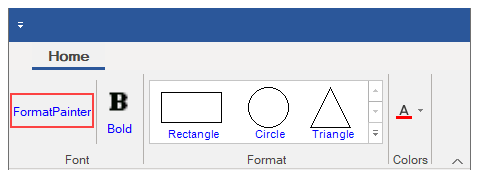A label displays content and can point to the element next to it. It can include both text and image.
The image given below depicts a label.

Add Label at Design-Time
The Ribbon Label can be added at design-time using the Ribbon Group Floating Toolbar or RibbonGroup Items Collection Editor. Also, you can customize the look of the Ribbon Label using the Ribbon Label Floating ToolBar or by editing the properties in the Properties Window. For more information about floating toolbars, refer this フリー ツール バー.
This image below shows the floating toolbar of Label.

Add Label via Code
The Label can also be added to the C1Ribbon control through the code using the RibbonLabel class. This is depicted in the code below:
Add Multiple Labels
C1Ribbon allows you to align multiple labels within your RibbonGroup using the MaxTextWidth and MinTextWidth properties. This section will walk you through the steps of adding multiple labels using two RibbonToolBars containing the default Ribbonlabel, a RibbonComboBox, and a RibbonLabel.
- Add two RibbonToolBars to your application. By default, the RibbonToolBar contains a Ribbonlabel.

- Float over the upper left corner of the first Toolbar until the glyph
 appears. Click the Action label and select Add ComboBox from the list.
appears. Click the Action label and select Add ComboBox from the list. - Click the glyph again and click the Action label again. Select Add Label from the list.
- Repeat steps 1- 3 with the second Toolbar.
- The Ribbon application should appear as in the following image:
- Select the RibbonLabel on the first Toolbar and choose Text Settings from the RibbonLabel Toolbar. In the Text textbox, enter This is a very long text string.
- In the RibbonLabel Properties window, scroll down to the MaxTextWidth property and set it to 130. Enter the same number for the MinTextWidth property.
- Select the RibbonLabel on the second Toolbar and choose Text Settings from the RibbonLabel Toolbar. In the Text textbox, enter This is another very long text string.
- In the RibbonLabel Properties window, scroll down to the MaxTextWidth property and set it to 130. Enter the same number for the MinTextWidth property.
- Press F5 to run your application. Your application should resemble the following image:

Change ForeColor
The ForeColor of an item typically refers to its text color. Users can change the ForeColor of the ribbon label item. The C1Ribbon class provides the UpdatingItemStyle event, which occurs before a style is applied to a ribbon item.

Let's see how to change the ForeColor of RibbonLabel by setting the UpdatingItemStyle event in the code snippet.
| C# |
コードのコピー
|
|---|---|
//RibbonLabel の前景色を設定するように UpdatingItemStyle イベントを処理します。 private void C1Ribbon1_UpdatingItemStyle(object sender, UpdatingItemStyleEventArgs e) { if (e.RibbonItem.GetType() == typeof(RibbonLabel)) { e.ForeColor = Color.Blue; } } |
|